Sustainability reporting from T2, EA, Paradox, Razer, Nvidia; PS5 energy saver mode explained; energy consumption of GDDR memory; and more! It's GTG Links 67

Hello GTG readers! Do you often think about how you belong to a slowly but surely expanding, slightly exclusive nexus of fans of both a liveable planet and the game industry? I do, and I think that makes you some of the best readers on this blue-green planet.
It's been a while since I had time for a links post (good lord I just checked and the last one was september!) so I've accumulated a huge backlog of ESG reports to discuss (perhaps the last ones for this year), plus more details on the new PS5 energy saver mode, some comments on that new "study" of physical v digital games distribution going around, some cool tidbits about the power consumption of high performance memory, and heaps more interesting theory stuff for the nerds on energy and climate. Lets go!
Take2’s impact report is out – and their absolute emissions are down by almost 20%, which is a substantial dip. And just as a bit of pre-clarification: I'm calling this report "about" 2024, even though it's technically FY2025 which covers April 1, 2024 to March 31, 2025. This is just one of the many, many complexities to iron out to make fair comparisons between companies, and there are so many different periods that corporate reporting can cover around the world. For simplicity I treat the year that has the most quarters in it as the "main" year its reporting on.
So what's was new in 2024 for Take-Two, and why the big drop? Well, it's largely a reduction in Scope 3 (value chain) emissions, which my first though was might be a result of the profit-constrained environment that the entire industry has been in for the past few years... reigning in spending, cutting back on non-essentials, etc. But I'm not sure that fits, as Take-Two is also one of the few firms that has largely avoided the cost-cutting elsewhere, and grew in headcount substantially from 2023 to '24, so perhaps that's not it. The news just out today that GTA VI's release date has slipped even further into 2026 also suggests they're still pouring investment into the project, and yet, Scope 3 emissions are still coming down.

Scope 1 & 2 emissions are up slightly, while Scope 3 are (or were, in 2024) down below 2022 levels. I would love more details on what the main drivers are, as it would give us some confidence that they won't just come back up again in the future. A slightly more detailed breakdown of what sorts of purchases are in that big chunk of S3.1 Purchased Goods and Services category would be illuminating. Breakouts for different categories like cloud, marketing, IT hardware, and others would be handy to have.
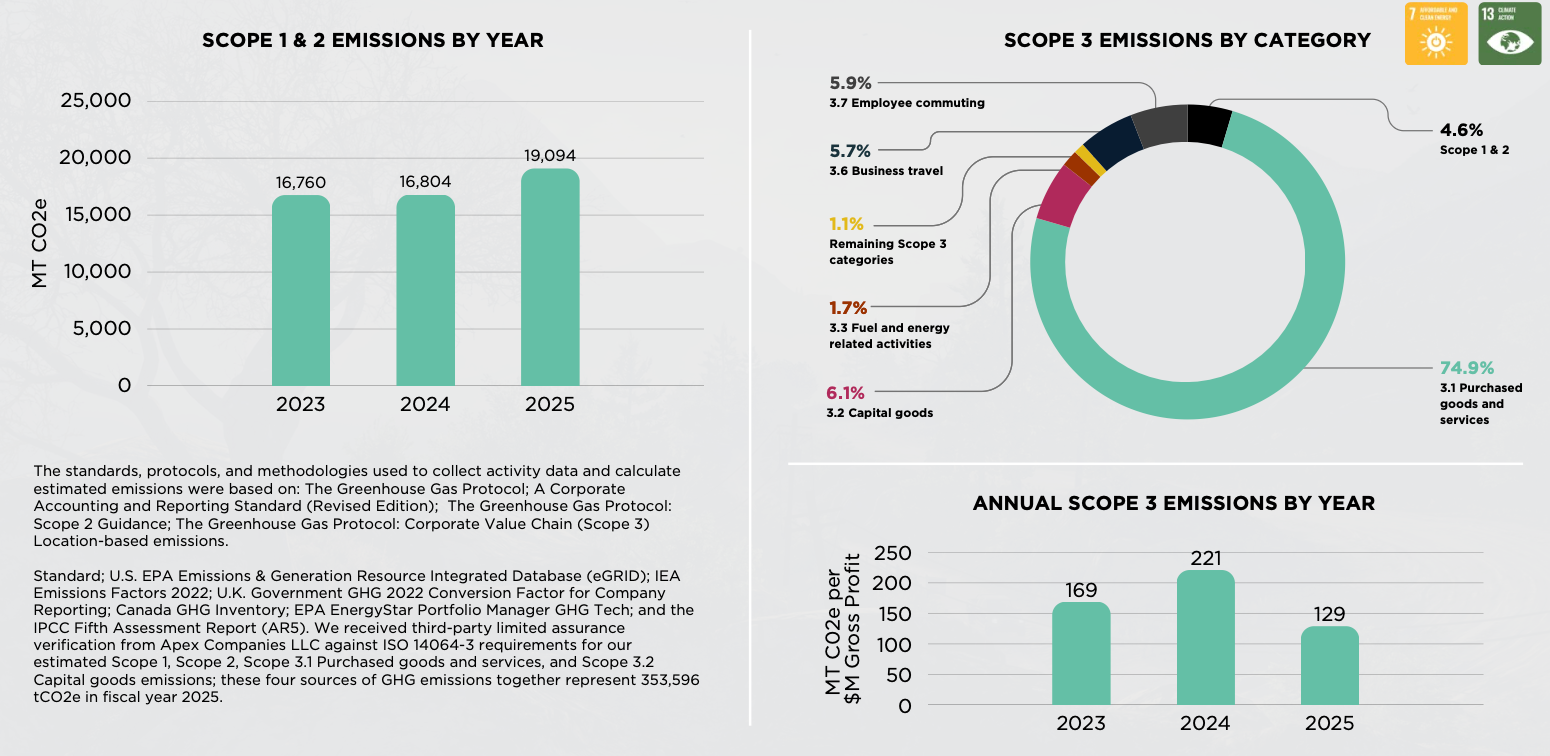
In any case here's the full report [PDF].
Electronic Arts impact report: perhaps its last?
One of the unfortunate consequences of the games industry's steady consolidation (along with the explosion in private (in)equity) over the past few years has been the disappearance behind the veil of private ownership of once public companies. This loss of transparency is partly why we (the SGA and EGDF) made a submission in favour of the UK's proposed implementation of ISSB S2 climate rules earlier this year to support the inclusion of certain large private companies in mandatory climate reporting. It's not the only reason, and you can read our submission about the rest of them – it was a rather extensive consultation.
But returning to the effects of consolidation: we've lost Activision Blizzard (which always had quite detailed reports) into the mothership of Microsoft losing some quite game industry specific detail into the broader Microsoft reporting framework, Keywords Studios International got bought in December '24 which means they are no longer required to publish annual reports to the public, and now Electronic Arts is about to be bought by a consortium featuring Saudi oil wealth, and which may very well go the same way. In other words – it's getting harder and harder to get a full picture of the sustainability trends in games! I don't know what else to do about this except to highlight, again, the need for a game industry GHG disclosure standard to encourage, facilitate and perhaps even compel fair, accurate disclosures.
While we have it though, we may as well learn what we can from this year's report.
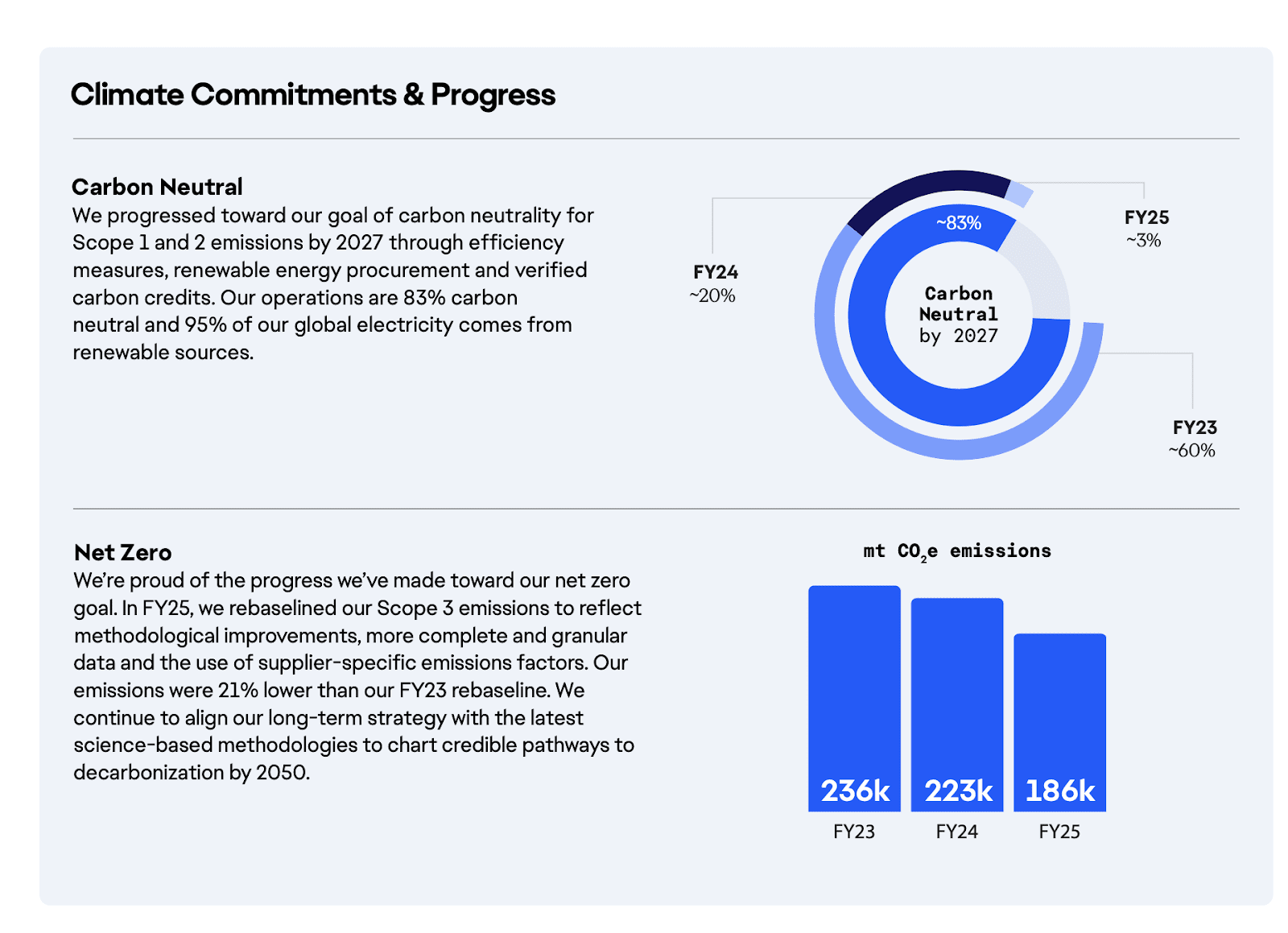
First things first – EA is confusingly using both "carbon neutrality" terminology about its own operational emissions (Scope 1 & 2) which is not best practice, and which parts of Europe (including Germany) have outlawed. Carbon offsets do not "cancel out" emissions elsewhere – and are increasingly viewed as a form of greenwashing. (More on new research on that later in the newsletter) It's also an extremely low effort strategy, doing nothing to transform the underlying dynamics of the business and drivers of emissions which, if you do have a more stringent target is only going to set you back.
And coincidentally, Electronic Arts does still have a more robust "net zero" target for 2050 – though there's no guarantee their new owners (the consortium includes a Jared Kushner investment vehicle after all) will uphold the same. I don't want to jump the gun, but could EA be the first games company to renege or pull out of a net zero target? This would be a dangerous backslide, but I can't rule it out.
What else is in the report? Well, the environment section is a mere four pages, so not a massive amount, but EA have done a "double materiality" assessment. Though it doesn't seem to quite meet the detail required by European ESRS double materiality standards – it's still better than nothing.

Lastly, we get a category by category breakdown of Scope 3 emissions – including revised numbers for past years. No Scope 3 Category 11 'Use of sold products' though, so the true footprint of all those Sims games and EA Sports titles will sadly remain a mystery.

Paradox’s annual report contains GHG disclosures
We don't often get the chance to feature too many small-to-mid size game companies on GTG – for one, because they don't tend to have the same reporting requirements and expectations as larger ones. But also, it's hard for smaller (though paradox isn't that small) games businesses to know how to measure and disclose emissions – as evidenced by the comment highlighted below!
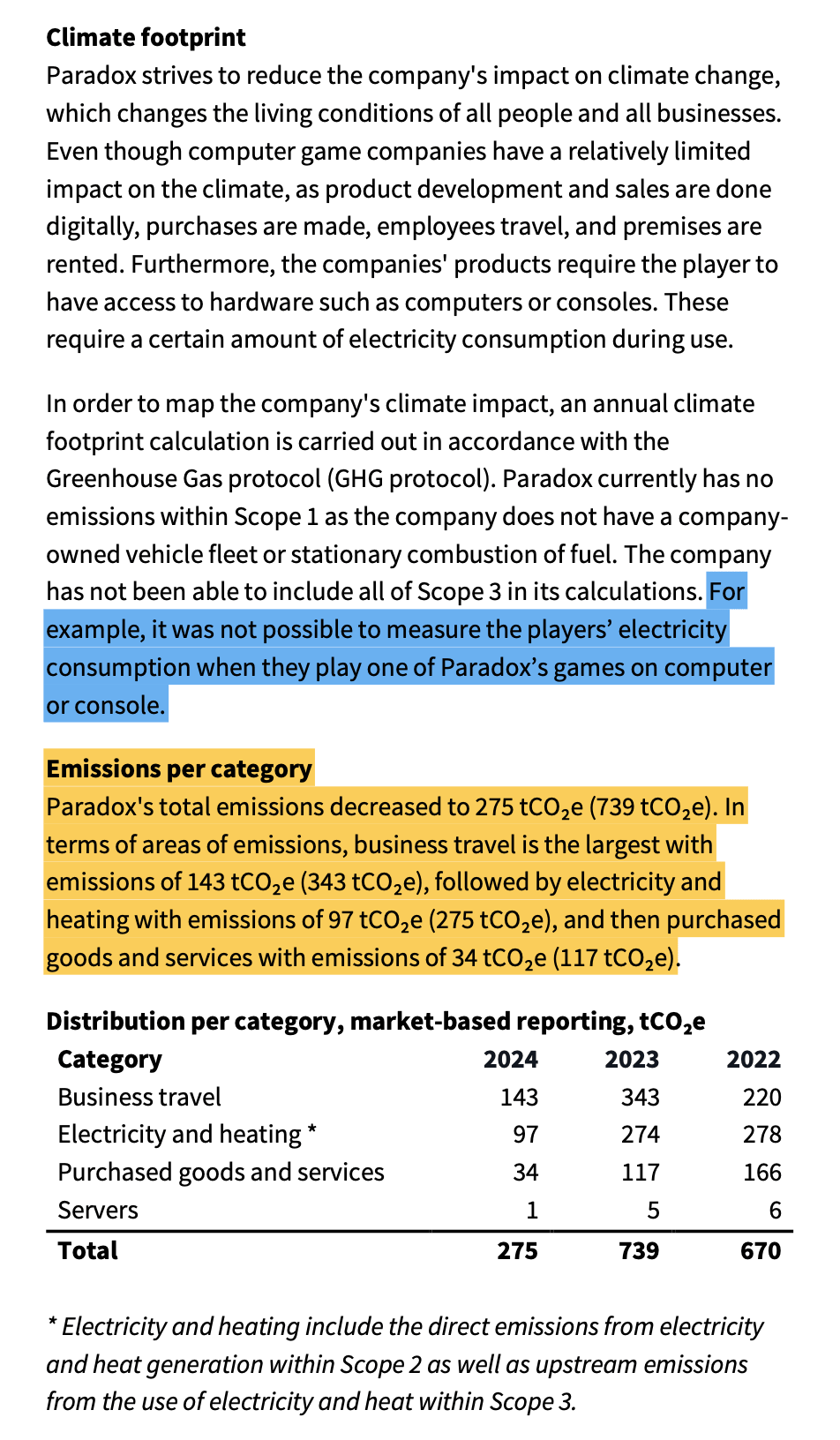
I have some good news though! Measuring (or at least, fairly and honestly estimating) players electricity consumption for Scope 3.11 Use of sold products is exactly what the SGA Standard provides! So here's hoping that Paradox and other companies are able to use these free and public methods and calculation tools to do so next year.
An update on industry GHG emissions
So based on the remaining games companies doing full and frank emissions disclosures I have been working on some new research, benchmarks and industry averages, the type of which I used to make available through the AfterClimate net zero snapshot (back when I had time for it!). We're currently strategising the new form that this might take at the moment so keep an eye on the SGA LinkedIn page for more insights from this work over the coming weeks.
But here's my top level takeaway now that most disclosures are done for the year – while 2023's emissions saw game industry GHG emissions reach a dubious high point, it's currently looking like 2024's emissions are down (at least those that have been disclosed). I remain very, very doubtful that this reflects an industry-wide emissions decrease though. There's still far too much missing from the picture to say anything for certain about it – several macro trends are still pushing in the wrong direction and until I see efficiency increases that beat the growth numbers I think the total footprint is likely to still be going up.
But, that aside, it is looking like at least in 2024 some efforts were paying off for some game businesses that made the investments in sustainability with continuing reductions in emissions, and that seems to hold even when we look at the per-revenue or per-employee intensity metrics. So that's some mild good news. More on this soon (I hope).
Razer does fairly robust ESG reports
Have a look at their top level takeaways, including a SBTi validated near-term target. Blimey! That's worth writing home about.

And not only that, they do some pretty detailed breakdowns of their corporate emissions footprint (including Cat.11 Use of sold products – so if you've been using a Razer mouse, keyboard or other device then your emissions have been (probably) estimated and disclosed. Neat.
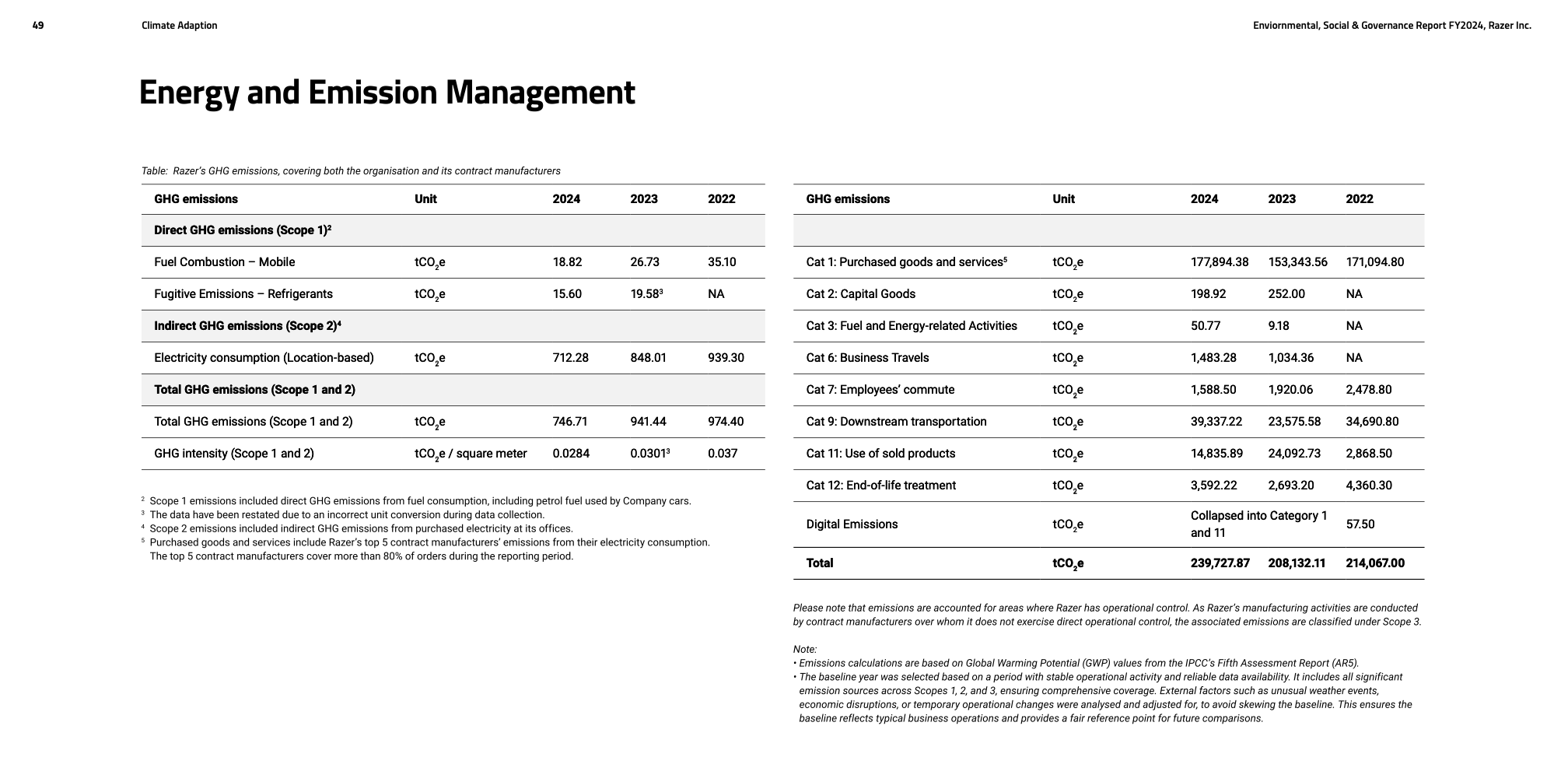
Next up – improved repairability? They're talking the talk on circular economy in their reporting, but all the repair content creators I see don't seem to have a high view of their products. ¯\_(ツ)_/¯
Nvidia did its annual report earlier in the year too
Post the Category 11 emissions from all those sold GPU's and AI chips, cowards!!! That's all I'll say about that.
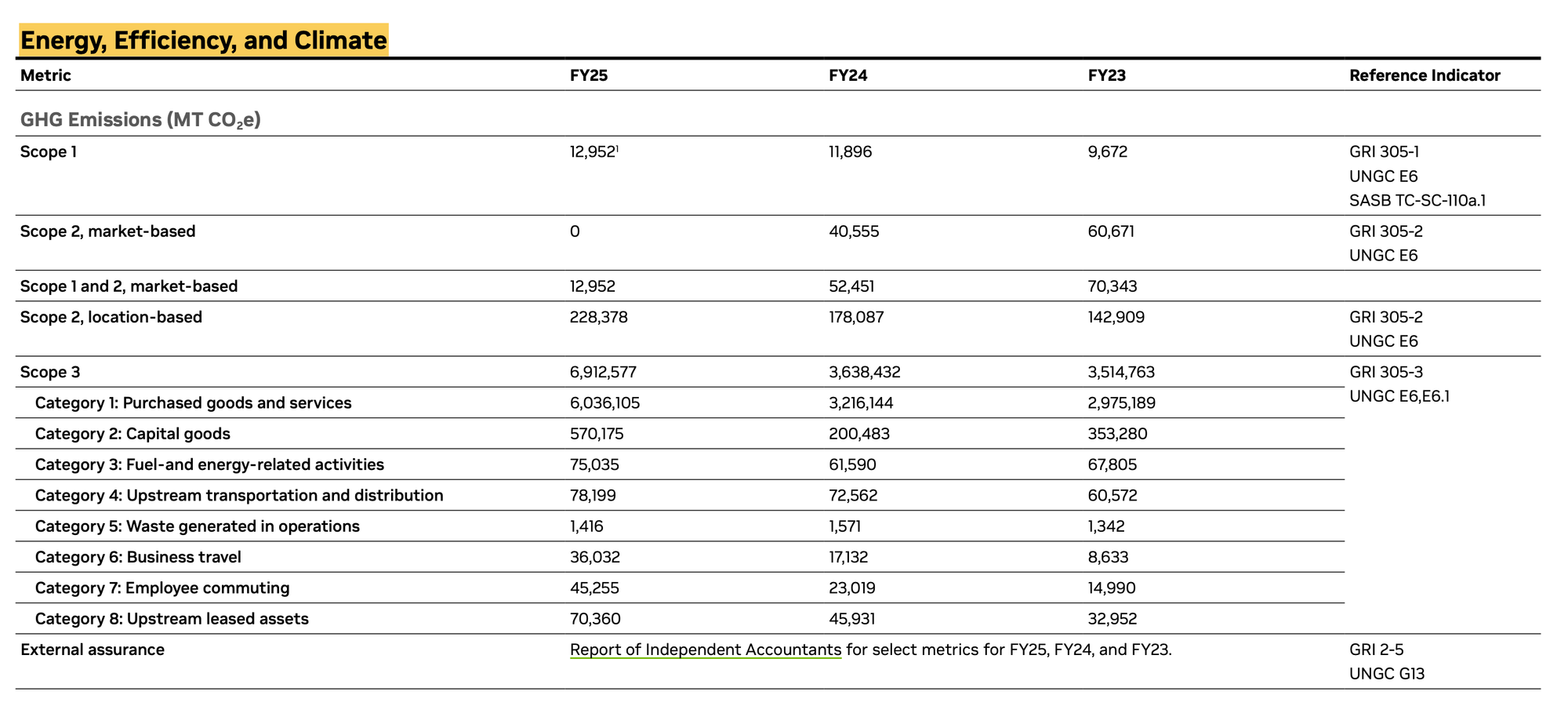
PS5's energy saver mode explained
So remember that "energy saver" mode for PS5 that Sony shipped? Finally, we have some more info on it courtesy of Digital Foundry. They seem to think that its existence stems primarily from a compatibility mode related to a forthcoming PlayStation handheld. Huh. Some of the details from the video and the kind of specific hardware limits involved were being shared online, and I've put a screenshot below.
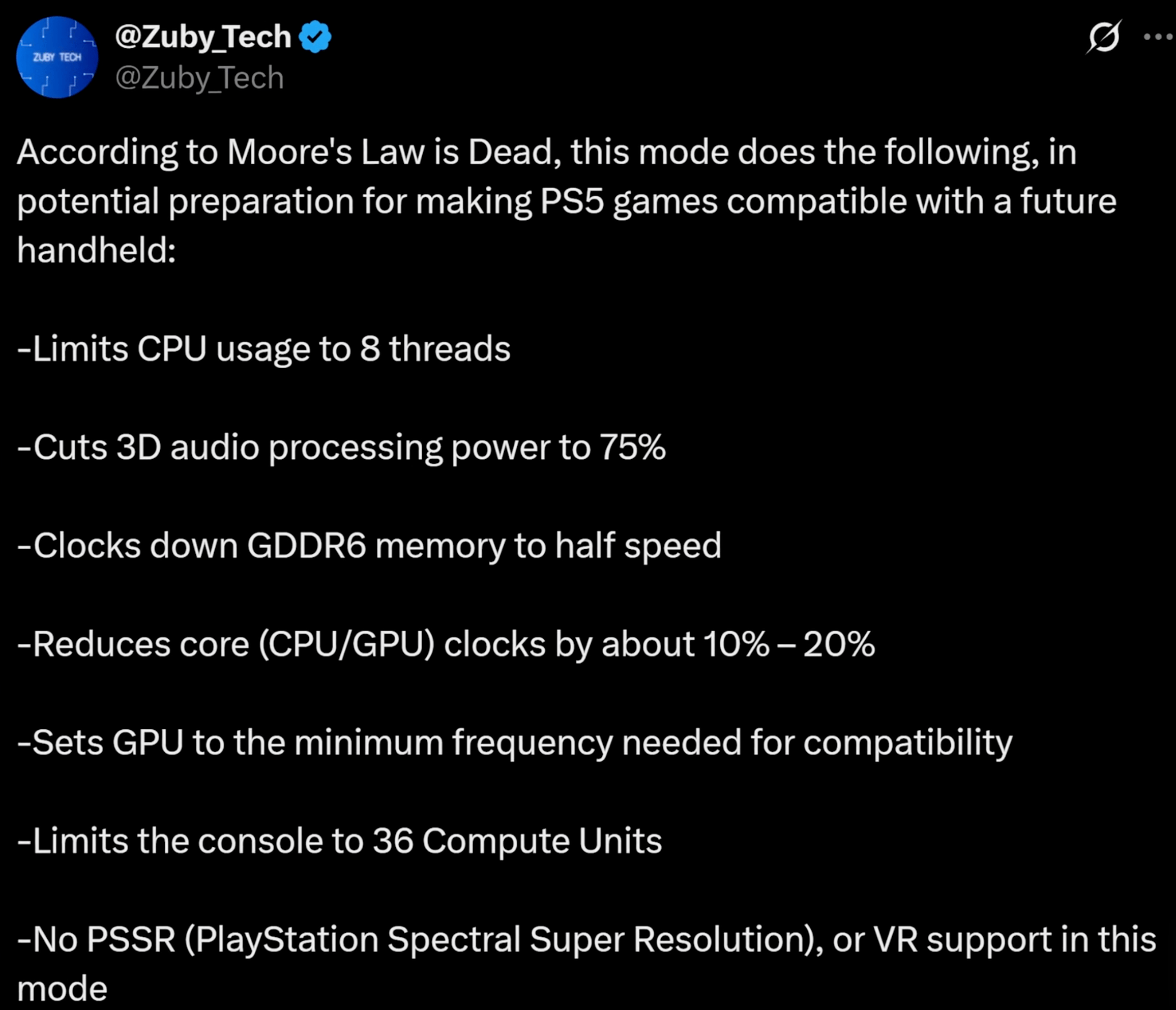
It's an interesting artefact for sure. I am curious to see what the take-up is like, and what any consequent energy and emissions savings are – if Sony will disclose them.
PS6 tech - possibly offering improved energy efficiency?

PlayStation and AMD had a joint meeting/announcement about their new partnership (Xbox recently announced something similar) with some interesting implications for next next gen hardware.
The technical details here are well above my pay grade, but this seems potentially promising?
Universal Compression, according to Huynh, is “a system that evaluates every piece of data headed to memory – not just textures – and compresses it whenever possible. Only the essential bytes are sent out, which dramatically reduces memory bandwidth usage. That means the GPU can deliver more detail, higher frame rates and greater efficiency.”
Cerny added: “There’s a multitude of benefits from this, including lower power consumption, higher fidelity assets and perhaps most importantly, the synergies that Universal Compression has with Neural Arrays and Radiance Cores, as we work to deliver the best possible experiences to gamers.”
As an aside – it'll be interesting to see whether AMD can start to take shots at Nvidia's crown as king of gaming graphics while Nvidia is distracted by its AI bet. Look at the size of the different Nvidia business segments... crazy stuff.

Speaking of game graphics.
Nintendo Switch 2 is comfortably the biggest console launch of all time

My read on this is that the graphical arms race is probably over, for now, or at least, it's of much declined importance to what is now the mainstream of gaming. The returns for those at the cutting-edge visuals seems have shrunk considerably, as well, which is not to say that there's nothing worthwhile in cutting edge graphics, but that they're not nearly as essential as they were. Cyberpunk 2077 runs on the Switch 2 after all.
Also I still haven't seen anything to contradict what I wrote three years ago (!!), that 8K gaming will never make sense.
LTT on the H200 AI card
Mainly sharing this for a couple of the interesting factoids that are buried in there for the die-hards (like yours truly).
We all know AI chips are power hungry, yeah? Turns out a decent chunk of that power demand comes from the huge amounts of memory required for AI models – with a screenshot from an Nvidia document that has some power consumption estimates for the GDDR6 (1.25-3.5W per GB/s) and GDDR7 (1.8-2.5W per GB/s) memory formats.

Seeing as the $30k AI chip LTT got their hands on has a whopping 141 GB of memory, that power really starts to add up!
GI.biz reported a new “study” on the carbon intensity of games

I was tempted to write a longer thing about this study, by Greenly, and which (to their credit) they don’t actually call a study but rather a “data story”, but the only thing I really have to say about it is that without providing any of the assumptions behind their calculations they've done there’s really no way anyone can (or should) use these numbers or treat them as gospel truth. Which is quite disappointing! Long time GTG readers will know that I always celebrate others doing work in this space, and doing what they can to contribute to this essential work. But the study linked to seems more about linking to a range of different secondary sources (which in a few cases are just summaries of my own work in one form or another) to create a compelling story.
What's missing is the actual specifics and details required to enable us to agree or disagree. I need an explanation of the often fine grained decision-making that has gone into the modelling process. The exercise of individual judgment is not a bug, it’s a feature of this process, and it reflects the messy nature of the world that we live in. There is often room for meaningful disagreement, depending on where one starts from, or even the lens one uses to look at the same facts and figures, but we need to know all those elements. Without them, all we have are appeals to authority.
tl;dr – Are physical games "100 times more carbon intensive than digital"? I still don't know for sure. At the very least, I think it depends on where you draw your boundaries, and what assumptions you make. For instance – there were scenarios in Joshua Aslan's PhD thesis from 2019 in which disc distribution (for very large game files and other variable conditions) had a lower climate impact. But again, it depends.
If you want to read the data story and see for yourself, a PDF version is available here.
Are carbon offsets fixable?
Perhaps one of the most important reviews of carbon crediting and offset approaches has been published, and it comes with some sobering implications. The long and short of is is many carbon credits are intractably broken, and require great care in selection for truly valuable projects. The average purchaser of carbon credits is not likely to be able (or willing!) to undertake this sort of diligence, and so we should focus on mitigation (actually reducing emissions at their source) and finding alternative financing modes for the remaining worthwhile projects.

The research got some coverage in news outlets as well with additional commentary from other researchers.

Carbon Credit Crash Out
And if you needed another example of how risky and unreliable these can be, here's one more:
But by 2023, after a summer drought, roughly half of the 500,000 trees planted by BrewDog on the hillside had died, according to responses to FOI requests made by Nick Kempe, a campaigner at Parks Watch Scotland. Soon afterwards, the brewer was scolded by the Advertising Standards Agency, which said that its claims to be carbon negative were misleading. In 2024, the company abandoned its carbon negative target and said it would stop applying to buy carbon credits.

Compelling piece on the prospect of a plastics treaty
A plastics treaty has been an important idea for dealing with the incredible burden it places on the planet – however a global treaty has failed to eventuate:
Negotiators again failed to finalize the text for a global plastics treaty in Geneva in August 2025. The talks exposed two harsh truths. Consensus on the treaty text, where no state formally objects, cannot be reached. And securing a high-ambition treaty is going to require launching a new process outside the United Nations (UN) framework.
But not all is lost – the piece goes on to talk about the many, many examples of agreements, treaties and conventions that don't involve whole world consensus (e.g. "the Rotterdam Convention to evaluate the risks and safety of chemicals and pesticides") which can still succeed at lifting standards, providing important incentives to actors, and eventually exert pressure even on recalcitrant players.
More published research on energy efficiency
It's a new theoretical framework for understanding the "rebound effect" of energy efficiency improvements, sometimes called the Jevons Paradox, which is the idea that improvements in energy efficiency can cause the use of more energy than has been saved through efficiency. It's an argument for a lot more analytical rigor, and it looks quite useful.
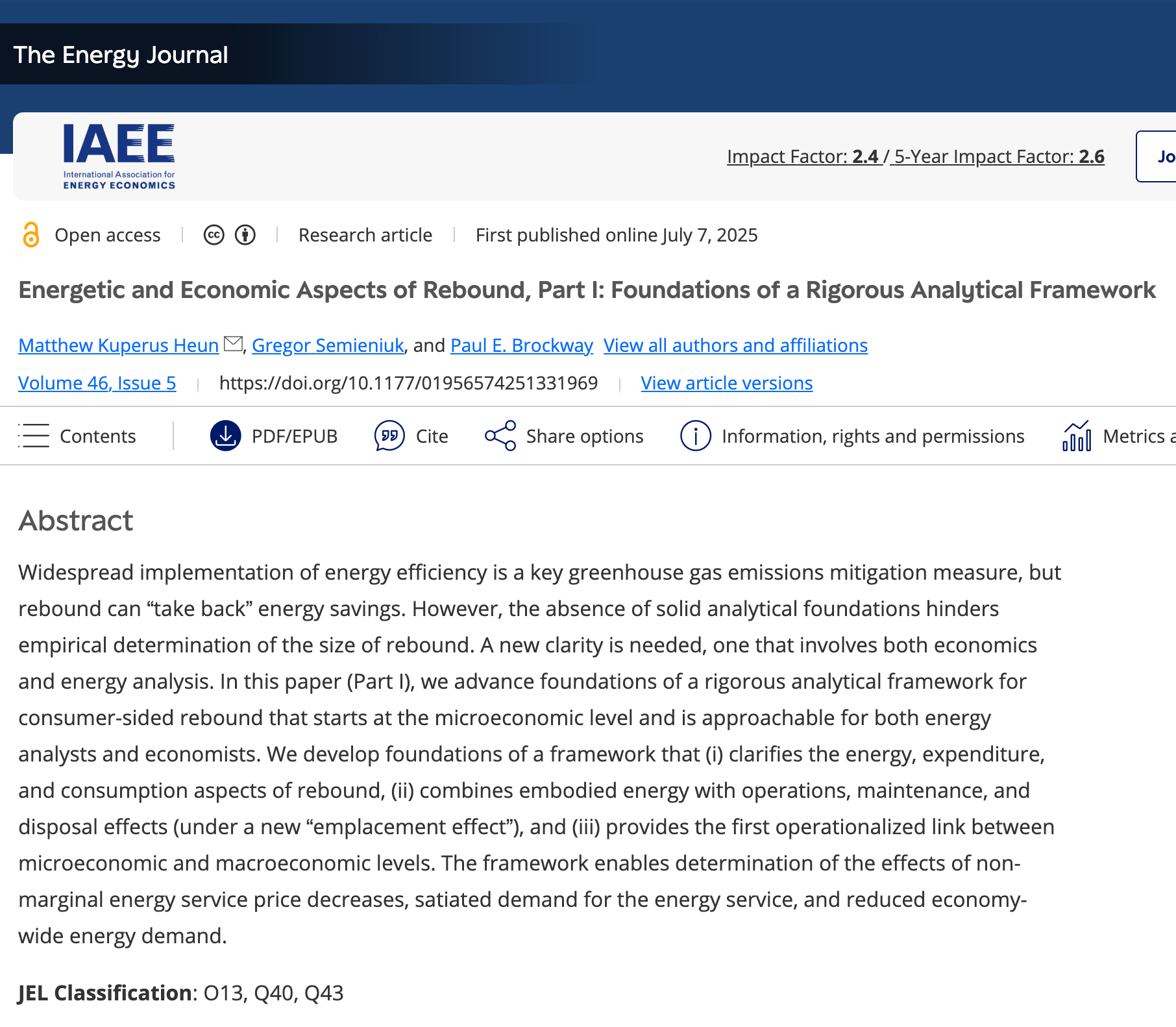
Another day, another data centre sustainability scandal
Amazon new its data centre water usage would be controversial. It should be!

Climate Denial as emotional defence of modernity
The true importance of viewing climate denial as a defence of modernity is to understand that anti-environmentalists have got something right: there is something fundamentally incompatible between the idea of environmental limits and foundational aspects of the modern world-view.
Seen from this perspective, it is no surprise the Limits to Growth report did not secure the kind of rapid political action its sponsors hoped for. It’s not just that the idea of environmental limits contradicts an underlying image of the modern individual, living in a world of ever-increasing progress. It’s that environmentalism has not offered an alternative vision, of equivalent explanatory power and emotional resonance.
Good piece! One to sit with.

Rare view inside Congolese Coltan mines
New Zealand’s government no longer picking up the bill for climate disasters
Better break out those flood maps and double check your insurance. We'll see whether this decision can survive the next wave of disasters.

That's all for today – thanks as always for reading Greening the Games Industry.
Don't forget you can join the ranks of the super cool elite tier exclusive GTG Supporters and help keep this project moving.








